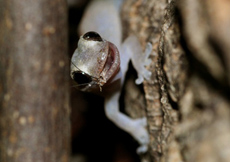Hemiphyllodactylus typus
(Bleeker, 1860)
Distribution:
Hemiphyllodactylus typus probably originated from the Philippine Islands, today it is spread worldwide as a true cosmopolitan in the warmer regions.
Description:
The type described here is a special case in biology. Hemiphyllodactylus typus has 3 subspecies. All of the ones currently available in central Europe originate from animals known as parthenogenetic populations. They are therefore similar to "Mourning Geckos", which are females who are able to produce offspring without a male partner. In the genetic sense, it is animals who share not only the same DNA, but are perfect clones of their mothers' right down to the pattern. The geckos come out at night rather light brown to beige. During the day the animals remain heavily contrasted and dark. Their tails remain far lighter than the rest of their body. Hemiphyllodactylus typus is for example more like Gonatodes and Sphaerodactylus, it is voiceless, which is rather rare in geckos.
Habitat:
Aforementioned Hemiphyllodactylus typus is at home all over the world. It prefers warmer regions with a tropical to subtropical climate. The geckos are mainly located in humid microclimates; on and under loose bark, in leaf axils of ferns or bromeliads and other herbaceous plants.
Husbandry and Breeding:
Hemiphyllodactylus typus is strictly crepuscular and nocturnal, therefore it is mainly only observed in almost total darkness. Due to their peacefulness several animals may be kept together in the terrarium. The terrarium should be higher rather than wider. For the design it is advisable to cover the rear and side walls with bark or cork, so more climbing space is available to them. By attaching additional pieces of bark or cork to the back wall, narrow cavities will be provided for additional hiding. The planting is up to you, but do note that climbing plants will offer the geckos more rear and sidewall coverage for even more added security. For completion of the terrarium design a few climbing branches should be offered.
Hemiphyllodactylus typus makes an excellent "nighttime commando" in a terrarium that is occupied by diurnal dwarf gecko species from the genus Gonatodes or Sphaerodactylus for example. All to often uneaten feeder insects become a nuisance by nibbling on plants or other terrarium decor. Nocturnal geckos are the perfect solution to this problem.
A terrarium measuring 40x30x50 centimeters will be sufficient for two to three animals, even if the terrarium is occupied by a pair of diurnal geckos. Since the geckos carry out "day and night shifts" they will usually never see each other. Daytime temperatures should range between 24-28°C (75-82°F) and at night they may drop safely by about three to seven degrees.
The females of Hemiphyllodactylus usually lay two eggs, however very rarely a single egg may be laid. The eggs will be hidden in different locations, but are often found in the columns of bark, leaf axils, in small tubes or under leaves. Usually the nesting sites are so well hidden that you can not find the nest. As the hatchlings are very small it is best to transfer any eggs you may find to an incubator. Depending on the incubation temperatures the young often hatch in captivity between 110-120 days. The hatchlings can be feed for a few weeks with small food, such as springtails or firebrats. The hatchlings may be raised in small converted household container. As the hatchlings grow rather quickly they can be moved to a more permanent terrarium around 2-3 months of age.
Adult animals should be provided with a varied diet. For example they will readily feast on micro crickets, Drosophila, Alphitobius diaperinus larvae, small isopods, firebrats and in the summer months field sweepings.
With a little patience and an LED night light, Hemiphyllodactylus typus can easily be observed at night. Hemiphyllodactylus typus is an interesting terrarium inhabitant, which should be in every dwarf gecko terrarium.





